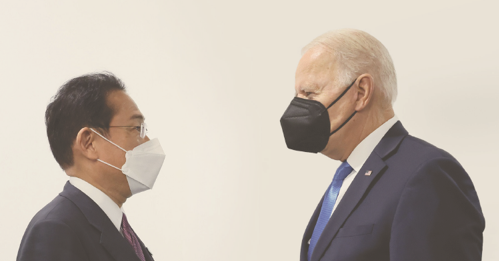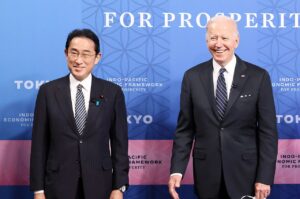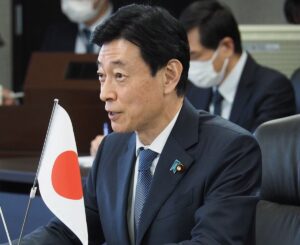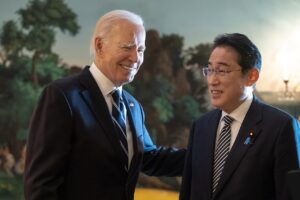Preface
I am pleased to present the most recent publication from the Stimson Center’s Japan Program. U.S.-Japan Alliance Cooperation in the Post-Pandemic World is the ninth volume of Views from the Next Generation, a series of policy briefs that offer recommendations for the most pressing concerns that Japan and its partners face today. Four Japanese scholars contributed chapters to this volume that explore what the U.S.-Japan alliance should be in a world that is changed by the pandemic and an evolving array of challenges.
Offering Japanese perspectives on the goals of the alliance and methods of engagement, the authors delve into mechanisms for cooperation, ongoing challenges in building technology partnerships, the growing importance of economic security, and the alliance’s broader role in the many organizations and fora of the Indo-Pacific region. Though the durability of the U.S.-Japan alliance speaks for itself, the authors identify areas of potential friction, evaluate the alliance’s approach to its goals, and suggest improvements to ensure the effectiveness of the alliance for the years ahead. These insights are valuable for Japanese and U.S. policymakers as the security environment of the Indo-Pacific shifts, and the strength of partnerships like the alliance matter more than ever.
My gratitude goes to Yuki Tatsumi for spearheading this annual project, an important part of Stimson’s work on U.S.-Japan relations. Her insights and analysis on the alliance and Japan’s defense policy have secured her status as a leading expert. This volume once again shows her efforts to amplify the perspectives of emerging scholars and facilitate a productive dialogue across the Pacific. I am also indebted to Pam Kennedy for her critical support of the project.
Finally, my colleagues and I are grateful for the continued support and guidance on this project from our friends that the Embassy of Japan.
Brian Finlay
President and CEO
The Stimson Center
Introduction
Yuki Tatsumi and Pamela Kennedy
More than sixty years after the signing of the security treaty, the U.S.-Japan alliance is shifting to meet the challenges of a world very different from that of 1960. The globe has been consumed by a pandemic for over two years; the climate is changing, with far-reaching impacts for billions of people around the world; trade has expanded and with it, new areas of the economy have emerged, especially digital; the Cold War ended but new threats to liberal international norms have arisen. The U.S.-Japan alliance has been a cornerstone in the Indo-Pacific region during these changes, but it has also evolved to keep pace with the times. As the pandemic moves slowly to its end, it is time to assess the alliance’s goals and modes of partnership, the environment that it exists within, and the new and old challenges that it must face.
In January 2022, Prime Minister Fumio Kishida and President Joseph Biden met in a virtual meeting to reaffirm the strength of the alliance and the U.S.-Japan commitment to a “shared vision of a free and open Indo-Pacific region.”1The White House. “Readout of President Biden’s Meeting with Prime Minister Kishida of Japan.” January 21, 2022. https://www.whitehouse.gov/briefing-room/statements-releases/2022/01/21/readout-of-president-bidens-meeting-with-prime-minister-kishida-of-japan/. The alliance has grown from a security-oriented pact with a focus on mutual defense to a partnership that encompasses regional security and prosperity, cooperation on the pandemic and climate change, commitments to stand up for human rights, and the value of cooperation with other allies and partners across the world.
The traditional security concerns that the alliance faces remain, though they are also expanding into new domains and different types of threats. The maritime security of the Indo-Pacific region’s two oceans and critical sea lanes has global implications for international norms, as tensions simmer in the East and South China Seas. The rapid development of the domains of space, cyber, and the electromagnetic spectrum over the past few decades have been spurred by technological innovation in the United States and Japan, as well as by partners and competitors.
There are emerging dimensions to the challenges facing the alliance, especially economic security, which is now acknowledged as a key element of national security. With the disruption of supply chains during the pandemic, global trade and investment is in an accelerated phase of adjustment as countries attempt to diversify their trade relations. Japan itself is building a whole-of-government effort to consider economic security factors across its ministries. In addition to the supply chain issues, a clearer understanding of China’s economic influence across the Indo-Pacific region has emerged over the past decade, raising concerns over the quality of investments and the extent of the accompanying political influence.
In the midst of these security pressures, there is a renewed need for the alliance to demonstrate its stabilizing role in the Indo-Pacific. The alliance has committed to a versatile set of roles and aspirations that requires flexibility and capacity to address various issues, as well as structure and coordination to facilitate cooperation – not only between the two allies but also with other partners. If the alliance is to effectively address the broad array of security concerns in the Indo-Pacific, then it demands regular assessment of how well it implements its goals, such as through the Competitiveness and Resilience Partnership (CoRe), the Global Digital Connectivity Partnership, the U.S.-Japan Climate Partnership, and the numerous other forums for U.S.-Japan cooperation. In addition to bilateral efforts, the alliance can also continue to leverage its partnerships in the region, such as the Quad, to cooperate on shared goals.
Stimson’s Japan Program has sought the perspectives of four rising Japanese scholars to examine several aspects of alliance cooperation, including the alliance’s role in the Indo-Pacific, technology cooperation, economic security, and the Quad, and make recommendations for strengthening the alliance in the post-pandemic world. As the U.S.-Japan alliance enters a new era of recommitment, these recommendations offer insight into the ways in which the multifaceted alliance is deepening and evolving to meet the challenges of the next few decades.
In “Reframing the Indo-Pacific and Managing Relations with Like-Minded Countries,” Riho Aizawa (Research Fellow, National Institute for Defense Studies) argues that in response to China’s expansion of its influence throughout the Indo-Pacific, the U.S. and Japan should reframe the region into six smaller and more manageable sub-regions to better increase coordination with the growing number of security-related actors in the region. Despite the close cooperation between the U.S. and Japan and their allies, Aizawa notes that the goals and priorities shared between like-minded countries have become less clear as security issues have intensified and the number of actors in the region has increased. To strengthen the FOIP vision in the region, Aizawa proposes using the framework of sub-regions to identify common interests and increase coordination, as well as to build effective cooperation with China’s neighbors or economically weaker countries in the region that have greater reliance on China.
In “Shaping U.S.-Japan Technological Cooperation After the Pandemic,” Naritada Miura (Program Assistant, Sasakawa Peace Foundation USA) examines the prospects for deepening U.S.-Japan technological cooperation. Miura explores how the U.S.-Japan alliance has evolved into a burgeoning technological interdependency. Through recent Japanese strategic adjustments, such as lifting the ban on arms exports, Japan’s roles and capabilities in the alliance have expanded, providing opportunities for collaboration. In three case studies that highlight the key challenges that the U.S.-Japan technology cooperation faces, Miura assesses specific obstacles for deepening cooperation. Miura offers policy recommendations for Japan to develop a mechanism for cooperation on dual-use technologies, enhance Japan’s domestic defense capabilities, implement a security clearance system, and gain cooperation from Japan’s private sector in these efforts.
In “The Japan-U.S. Alliance and Economic Security Challenges in the Indo-Pacific,” Ippeita Nishida (Senior Research Fellow, International Peace and Security Department, Sasakawa Peace Foundation) assesses the economic security dimension of the U.S.-Japan alliance and the necessity of strengthening partnership to address direct and indirect challenges to economic security. Delving into the context of the economic security debate in Japan, Nishida notes that Japan must strike a balance between its deep economic relationship with China and the increasing need to bolster Japan’s economic security. Amid the turbulence of supply chain disruptions during the pandemic, the Kishida administration is attempting to implement a comprehensive economic security policy to improve Japan’s security as well as U.S.-Japan coordination, though challenges remain on both fronts. In his recommendations, Nishida urges the establishment of coordination mechanisms and economic engagement programs with Indo-Pacific partners, and greater trust and alignment between the U.S. and Japan on economic security matters.
In “The Quad as a Coordination Hub for Managing Multilayered Indo-Pacific Minilateralism,” Ryosuke Hanada (Research Student, Macquarie University) evaluates how the Quadrilateral cooperation between Japan, the United States, India, and Australia (the Quad), which has recently expanded beyond solely security cooperation to encompass an array of global issues, could be used to promote multilayered minilateral relationships to achieve the mission of the Free and Open Indo-Pacific. Hanada surveys the practice of minilateralism across the Indo-Pacific region, analyzing the criteria that make a minilateral successful, and asserts that the Quad has potential to clarify its own purposes and to be a hub for other minilateral arrangements. Hanada makes recommendations for the Quad’s future, either institutionalized as a strengthened Quad with goals and norms, or as a networking mechanism to facilitate various kinds of cooperation between its members and external partners.
We hope these chapters will give readers a fresh perspective on what the alliance has become in more than sixty years of striving to improve cooperation, the urgent challenges within and outside of the alliance, and the policy options that can bring Japan and the United States closer to their mutual goals.
About the Experts
Riho Aizawa is a Research Fellow at the National Institute for Defense Studies at the Ministry of Defense of Japan, where she specializes in the U.S.-Japan security alliance and sea lanes in the Indo-Pacific region and the Arctic. She previously served as a Policy Research Fellow at the Reischauer Center for East Asian Studies at the Johns Hopkins School of Advanced International Studies (SAIS) and as a Research Intern at the Hudson Institute in Washington, DC. She earned her master’s degree at the Graduate School of Gakushuin Women’s College and studied at the Elliott School of International Affairs at the George Washington University. She is a Young Leader at Pacific Forum and speaks English and Japanese.
Ryosuke Hanada is research student at Macquarie University since 2021. He has been a Research Fellow at the Japan Institute of International Affairs (JIIA), researching Japan’s foreign policy in the Indo-Pacific region since 2016. He also worked for the Council of Security Cooperation in the Asia Pacific (CSCAP) Japan. His prior experience includes several fellowship programs, including the Japan-U.S. Partnership Program of the Research Institute of Peace and Security (RIPS), the Young Strategist Forum of the German Marshall Fund (GMF), and the Strategic Japan Program of the Center for Strategic and International Studies (CSIS). He holds an MA from the University of Warwick and BA in Law from Waseda University.
Naritada Miura is a Program Assistant at Sasakawa Peace Foundation USA since December 2021. Previously, he interned at the Hudson Institute, focusing on the U.S.- Japan security alliance, Japan’s national defense strategy, and Japan’s economic security strategy. He also interned at the Japan Information and Culture Center, Embassy of Japan in Washington DC. While attending University of Maryland, he was a Student Assistant at the Gordon W. Prange Collection and conducted research on the Constitution of Japan. Miura graduated with a BA in Government and Politics with an International Relations Concentration and a certificate in East Asian Studies.
Ippeita Nishida is a Senior Research Fellow of the International Peace and Security Department at the Sasakawa Peace Foundation in Japan. He serves as an expert panel member of the “Development Assistance Accountability Committee” at the Ministry of Foreign Affairs of Japan, and he teaches at the Hosei University and the Aoyama Gakuin University as an adjunct lecturer. He previously was a research fellow at the Tokyo Foundation where he worked on several key policy research projects and published reports, including “The Quad Plus: Towards a Shared Strategic Vision for the Indo-Pacific” (co-editor, Wisdom Tree Publisher, 2015), “Rethinking Japan’s Foreign Aid: Widening the Scope of Assistance from a Security Perspective” (co-author and editor, the Tokyo Foundation, 2014), and “Maritime Security and the Right of Self-Defense in Peacetime” (co-author and editor, the Tokyo Foundation, 2013). He earned his MSc in Development Studies from the London School of Economics and Political Science.
Yuki Tatsumi is the Director of the Japan Program and Co-Director of the East Asia Program at the Stimson Center. Previously, she was a Research Associate at the Center for Strategic and International Studies and the Special Assistant for Political Affairs at the Embassy of Japan in Washington. She is the author of numerous books, monographs, and articles on the Japanese defense establishment, the U.S.-Japan alliance, and security dynamics and challenges in Northeast Asia. In September 2006, she testified before the House Committee on International Relations, and she is a recipient of the 2009 Yasuhiro Nakasone Incentive Award. In 2012 she was awarded the Letter of Appreciation from the Ministry of National Policy of Japan for her contribution in advancing mutual understanding between the United States and Japan. A native of Tokyo, she holds a BA in liberal arts from the International Christian University in Tokyo, Japan and an MA in international economics and Asian studies from the Johns Hopkins University School of Advanced International Studies.
Pamela Kennedy is a Research Analyst with the East Asia Program at Stimson. Her research interests include Northeast Asian international relations, U.S. alliances in Asia, and the role of the U.S. in the Indo-Pacific region. She holds an MA in International Relations and International Economics from the Johns Hopkins University School of Advanced International Studies and a BA summa cum laude in Government and East Asian Studies from the College of William and Mary. Prior to joining Stimson, she interned with the Center for Strategic and International Studies’ Japan Chair and the Reischauer Center for East Asian Studies. She previously worked at the Federal Reserve Bank of San Francisco.
About Views from the Next Generation
Views from the Next Generation is a series of policy briefs by emerging experts on the most pressing security challenges facing Japan and the Indo-Pacific region. Published annually since 2014 by the Stimson Center’s Japan Program with support from Japan’s Ministry of Foreign Affairs, the series raises awareness in the U.S. of issues ranging from peacekeeping to nuclear weapons – all from the perspective of the next generation of scholars and researchers – through public seminars and free distribution of the report. With each group of authors who visit Washington, D.C. for the report launch, ties between the American and Japanese security policy communities deepen.
Past volumes of Views from the Next Generation:
- Japan-Taiwan Relations: Opportunities and Challenges (2021)
- Key Challenges in Japan’s Defense Policy (2020)
- International Disaster Response: Rebuilding the Quad? (2019)
- Balancing Between Nuclear Deterrence and Disarmament (2018)
- Peacebuilding and Japan (2017)
- Japan as a Peace Enabler (2016)
- Japan’s Global Diplomacy (2015)
- Japan’s Foreign Policy Challenges in East Asia (2014)
Trailer
Notes
- 1The White House. “Readout of President Biden’s Meeting with Prime Minister Kishida of Japan.” January 21, 2022. https://www.whitehouse.gov/briefing-room/statements-releases/2022/01/21/readout-of-president-bidens-meeting-with-prime-minister-kishida-of-japan/.




